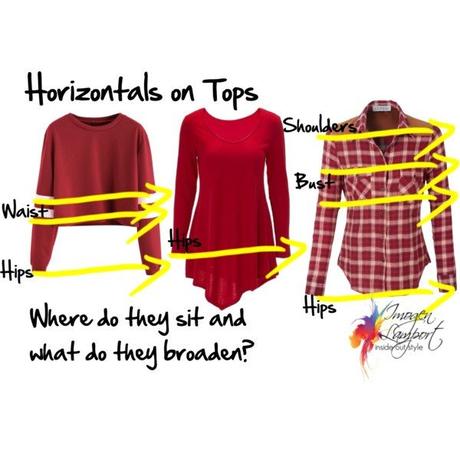
Before you take that garment into the change room, understanding the illusion of line really helps you choose clothes that flatter your figure.
Lines are used in clothing design in a number of ways:
- As part of the silhouette – that’s the outline of the garment
- In the construction – that’s all the seams that hold it together
- As design details – that’s the fun stuff like pockets and plackets and decorative detail
What kind of lines they are and where they sit on your body can make you look taller, shorter, wider and narrower. All the ‘rules’ on what to wear for each body shape really just relate back to the illusion of lines, and what they are doing to your body.
Knowing how to use lines judiciously will give you a complete head-start when choosing what to take into the change room (whether that’s a virtual change room or a real one).
Let’s discuss the power of the horizontal line.
Horizontal lines:
- Create balance
- Visually widen the area they are placed on
- Are created by most hems on garments
 Imogen’s Three Rules of Horizontal Lines
Imogen’s Three Rules of Horizontal Lines

- Never put a horizontal line on a body part you want to minimise or make look narrower. This includes hems, details and silhouette elements.
- The eye fills in the line. So two short horizontals can create one long horizontal across your body if they line up on a garments such pockets, sleeves, cuffs etc.
- We look for horizontal lines first. We we see something, we look for the horizontal line first as it gives us balance. So put horizontals on areas you want to broaden (to balance other areas) and take note of where horizontals fall on your body.
So let’s put this knowledge into action.
Rule 1 – Horizontals Broaden
I often call this the “Where do I end My Hems” rule.
Make sure your hems sit on the narrower parts of your body, unless you want to add extra curves to that area (and some of us do want to add extra curves!). Remember there are hems on sleeves and pants as well as tops. Waistbands count as hems too! Some collars and necklines also create horizontal lines (such as boat necks).

So if you don’t want to broaden your hips or thighs, don’t end tops at the widest points of your hips or thighs.
If you don’t have a defined waist, don’t broaden it with a belt or obvious waistband.
But, you can also use this rule to balance the wider parts of you. Want to balance your more curvaceous hips? Then add horizontal details to your shoulders.
Want to make your square shoulders look narrower? Then add some horizontal details to your hips.
You can decide what you want to broaden and choose to add a horizontal to this area.
Find out more about the horizontal line rules for your body shape in your Body Shape Bible which you can do the quiz and download here.
Rule 2 – The Eye Continues the Line
So our eyes keep on going and even if there is a short horizontal line, our eyes will fill in the gap between two short horizontals – such as sleeves, pockets and cuffs.

If you don’t want to add more width to your thighs, avoid jeans with whiskering at the crotch and pants or skirts with obvious pockets on the thighs.
Rule 3 – We See Horizontals First
That is, before verticals, and those are the slimming lines!

Yes we usually want to look for items that aren’t all covered in horizontal lines, we want to make sure we find a few vertical lines in our outfits (more on that here). But we see the horizontal lines first as we are always looking for the horizon as that gives us balance.
You want to be careful that your outfits aren’t ‘horizontal dominant’ if you are hoping to look either taller or slimmer.
This is why we can also use the horizontal line to balance our body – it draws attention to where we want people to look as well!
Narrow Horizontals Lengthen
Now, just one little caveat! Not all horizontals are broadening! That’s right.
When the horizontals are too fine for the eye to follow along one at a time, and when there are multiples of them, they can actually start working like a vertical line and become elongating.
In fact it doesn’t matter the direction of the line. Wide stripes widen (particularly when there is an obvious change of colour).

So before you take that garment into the change room, have a good look at it and decide where the horizontals are, and if you want them to fall on that part of your body!


